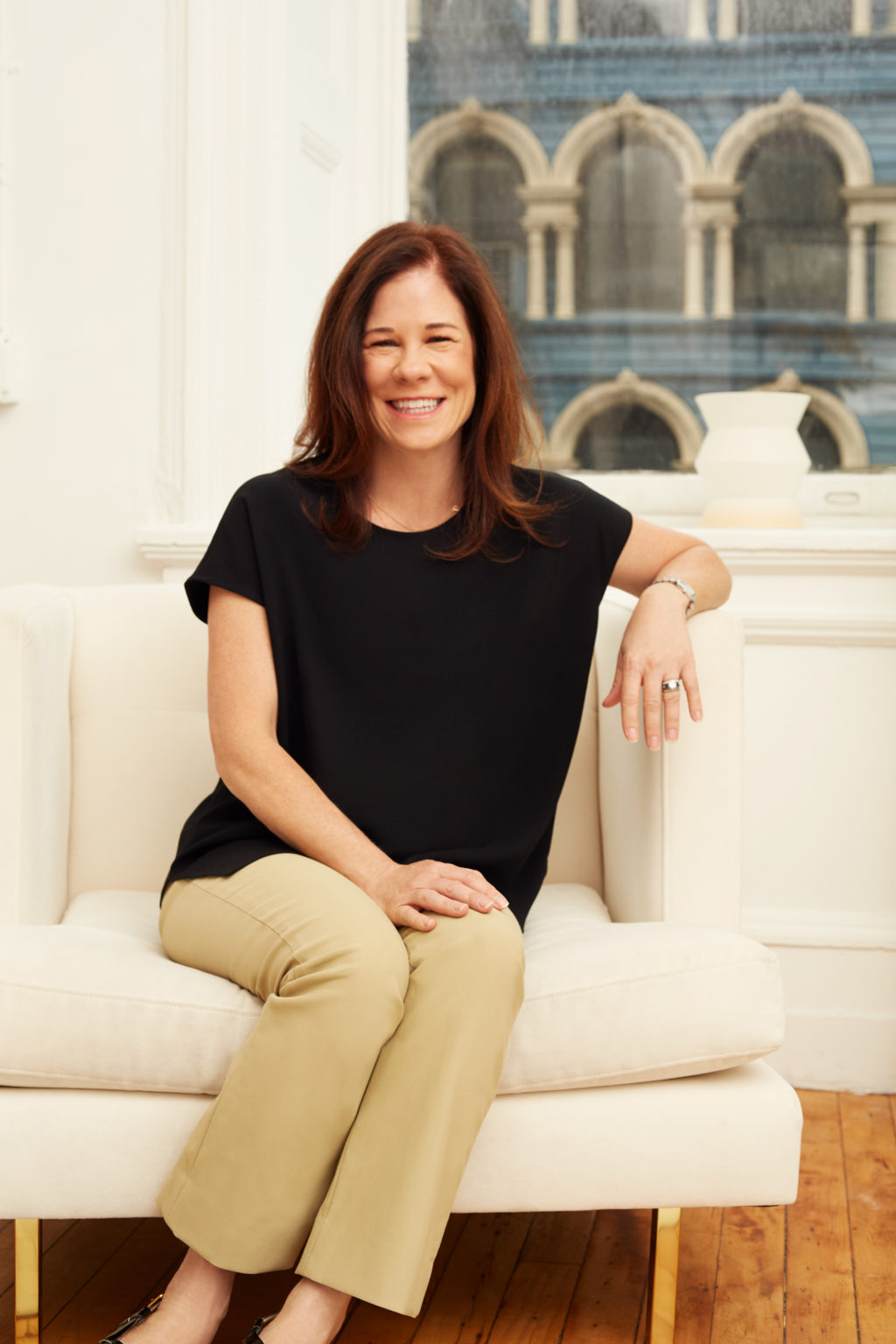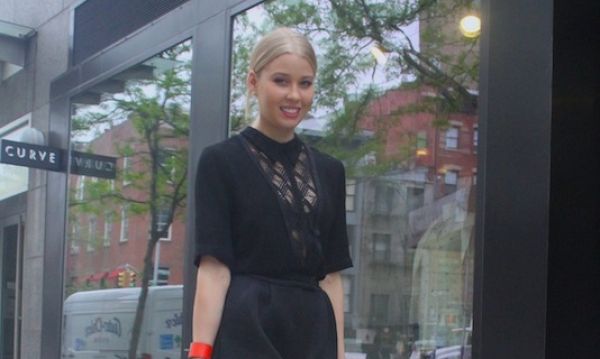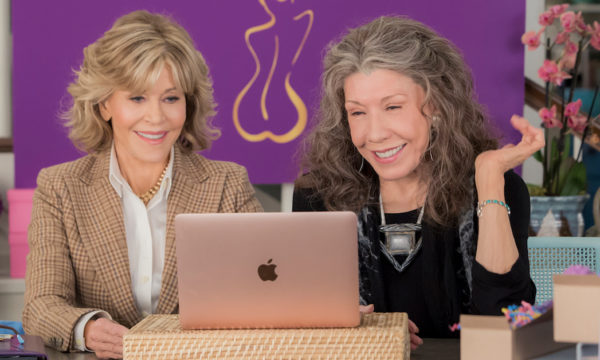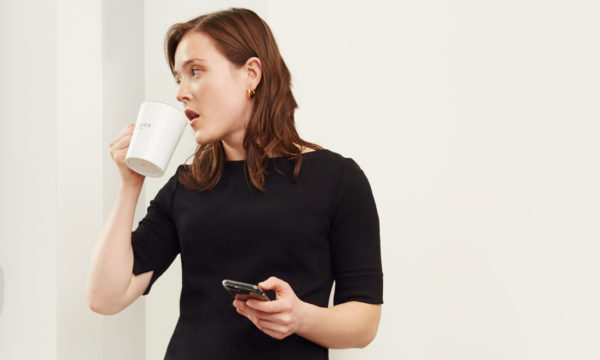Tara Sorensen Is Defining the Next Generation of TV Watchers
August 04, 2017 | Filed in: Woman of the Week
If you know anyone under the age of 10, they’ve probably watched—nay, been obsessed with—a show that Tara Sorensen has produced. Five years ago, she became the first executive of children’s programming at Amazon Studios, and has gone on to create Emmy award-winning series like Lost in Oz, Little Big Awesome, and Tumble Leaf. Riding on her success, Amazon is beefing up its kids’ content this year, and she’s currently developing a comedy with Bryan Cranston and Greg Mottola, Dangerous Book for Boys. (We hope a Daring Book for Girls is in the works, too.) She visited our showroom a few weeks ago to talk about her path to children’s media, how her own kids affect her work, and the importance of failure at every age.
I’M ATTRACTED TO CHILDREN’S MEDIA partly because I had a really wonderful childhood. I remember reading books and singing songs and having these meaningful moments with my parents and my sister every night at bedtime. In college, whenever I was in the campus bookstore, I would roam around and inevitably find myself in the children’s section. I once got a nebulous paper assignment and took it as an opportunity to compare Alice in Wonderland to a story by Joyce Carol Oates. This comfort and passion for children’s stories framed who I was, and although I couldn’t have told you I wanted to get into children’s media, that’s probably because I didn’t think it was a viable career at that point.
I STARTED OUT as a business major at USC. Then I realized that I didn’t care much for economics—what I really loved was reading. So I switched to English literature. Upon graduation, everyone assumed I wanted to be a teacher, but children’s media seemed more in line with my interests. My first job was at the Children’s Television Workshop, because I loved Sesame Street. I came to find out that they were only in production six months out of the year, but they did have a job in their publishing group. So I started as an editorial assistant at Kid City magazine. After about a year in New York, I found myself missing the L.A. weather, so I relocated back there. Because there’s not a big publishing industry in California, the next and most obvious jump was into children’s television.

Tara wears the Didion top in black with the Oshima pant in dune grass.
WHENEVER YOU’RE TALKING to a group of adults about their favorite prime-time television, it’s an interesting conversation, but if you ask those same adults what their favorite children’s story or children’s program was, you see this different look come over their faces. Smiles grow, and they becomes nostalgic and emotional. There’s a power behind the medium that I want to make sure we are always considering as we develop new programs. They’re not just fluff; they’re meant to become a lifelong experience for the child and the parent.
I HAVE AN IDENTICAL TWIN SISTER, and we grew up in Brooklyn. Up until about seventh grade, we were in most of the same classes together. By the time college came around, we thought it was important that we separate. So my sister went to NYU and I went to USC, and our relationship became stronger because of it. I don’t remember being competitive with her; my knee-jerk reaction was to push against people grouping us as one. People would refer to us as “the twins,” and going to a different school was a rebellion against that; I wanted to be acknowledged as having my own personality. My sister eventually went into finance, so now it feels like our lives are very different. Because I’ve lived across the country for so long, people often don’t know that I have a twin sister, and when they meet us, there’s this initial shock—then they can pinpoint different personality attributes. I promise, though, if you looked at our GPAs, they were very similar. We just chose different career paths.
I STILL CONSIDER MYSELF a New Yorker, and yet, L.A. has been my home for 20 years. We live in Manhattan Beach, which is very close to the ocean, so beach rituals are part of our everyday, even if I’m just driving along it on my way to work; it calms me. On the weekends in the summer and spring, the kids will go surfing or boogie boarding, and I’ll just bring a book and hang out next to the water. In the winter, we’ll usually drive up to Mammoth to snowboard and ski.
I WORKED IN THIS INDUSTRY for a decade before I had kids, who are now 10 and 11, and the content definitely took on a new significance after I became a mom. When I started at Amazon, my children were transitioning from Montessori to the public school system, and we found that a lot of different things weren’t available to them anymore, especially in terms of music and arts. Looking at how the school was preparing my kids, it felt like there was something missing. So our goal in programming was to focus more on right-brain thinking, not fact regurgitation. Obviously, we want to create fantastic stories and great characters that our customers love, but ultimately, I feel a responsibility as a parent to make sure that screen time becomes more meaningful and substantive. We think about how we can infuse stories and characters with meaningful traits that encourage kids to go out into the world and be more resilient, think outside of the box, take risks, and embrace failure.

Tara wears the Rachel dress in midnight blue.
HOW CAN WE PREP CHILDREN for a future that has yet to be defined? There is a lot of thought and expertise that goes into creating those programs so that they will have a greater, lasting impact. We have a thought leader board, in addition to preschool experts, that includes Jessica Lahey, who wrote The Gift of Failure, and Ellen Galinsky, the author of Mind in the Making. I wanted to make sure it wasn’t just about us saying that the shows were good; I wanted to validate the shows with the thought leaders’ body of work, and show parents why we thought it was good for their child’s development. With every show, we will figure out the creative details from a story and character standpoint, and then we will dig a little deeper to figure out what its curriculum could be, from more of a psychological standpoint.
BEING A MOTHER AND AN EXECUTIVE, things aren’t always perfectly in sync, but hopefully in totality I am able to give everyone equal attention. Pilates helps with balance, too. I have a really supportive husband, and I think my kids are more independent because I work a lot, so I can rely on them to get their homework done without having to harp on them.
I WAS GOING THROUGH A TOUGH PHASE in my career right before I came to Amazon. I was an independent producer, and I was finding it difficult to sell programming because I wasn’t aligned with a network. I had this moment of personal crisis where I thought, “I can make television shows, but if the content market is suffering, what else can I do?” And I really struggled for six months or so, thinking about what my next career move would be. That’s when I got this call from Roy Price, the head of prime video global content and Amazon Studios. I was their first hire on the programming side. I did not know what the job fully entailed when I took it, but I did know that I needed to make a change, and that experience in the digital landscape would be important for me, if I was going to be viable as an executive. And ultimately, I thought, “If it doesn’t work, I will have some experience, and that will be valuable.” I think that mentality of “if this doesn’t work, I’ll try something else” really allowed me to think more creatively about what we could be doing. And here I am, five years later.
WE’VE NOW WON SEVERAL INDUSTRY AWARDS, which is not something we set out to do, although it is wonderful. But honestly, the feedback that we get from customers and parents talking about how these shows are beneficial for their children’s development is the most powerful validation I could get. We had one parent talk about how they hope that Tumble Leaf defines their daughter’s generation, and that means so much to me.
Photos by Maria Karas.








